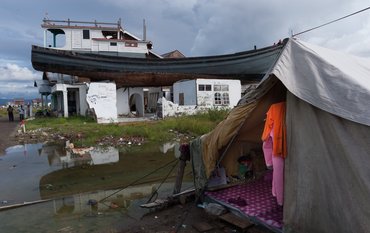The European Flood Directive requests the European Union member states to provide risk management plans for all areas with potentially significant flood risk. Nationwide flood risk assessments are also important to support climate change adaptation policies. For the prioritization of the investments based on decision‐support frameworks like cost-benefit analyses, comprehensive large-scale risk assessment models are essential tools.
For the first time, spatially consistent flood risk estimates for the residential, commercial and agricultural sectors of Germany were derived using the Regional Flood Model (RFM). It is a process-based flood risk model developed by Section Hydrology, GFZ. The RFM couples the weather generator providing spatially consistent precipitation fields with the hydrological and hydrodynamic models considering processes such as dike overtopping and hinterland storage. The coherent heterogeneous return period flows result in flood maps consisting of inundation depth and duration. These are intersected with sector specific assets at high spatial resolution. Detailed flood loss models are used to estimate losses. Using the RFM, we simulate a 5000-year flood event catalogue from which flood risk curves are derived based on the losses per economic sector. The process-based, spatially consistent flood risk estimates by RFM are an important step forward, since they avoid overestimation of losses for specific high return periods by taking spatial dependencies in return periods throughout the catchments into account, the risk estimates are more realistic compared to other large-scale assessments that commonly use homogeneous return periods along the entire river network.
From the risk curves, we estimate the Expected Annual Damage for Germany to be 529 million Euro. The losses corresponding to a 200-year return period are estimated to be 8.865 billion Euro. The commercial sector dominates by making about 60% of the total risk, followed by the residential sector. The agriculture sector gets affected by small return period floods and only contributes to less than 3% to the total risk. Across catchments, the Elbe, Danube and Rhine share about 90% of the total risk. These results support the investment decisions of the national flood protection program and stress the necessity to quantify, communicate but also further reduce uncertainties in flood risk assessments also for extreme events. The presented results should be regarded as first estimates, which can serve as a benchmark for future German-wide flood risk assessments.
Scientific Publication Sairam, N., Brill, F., Sieg, T., Farrag, M., Kellermann, P., Nguyen, V. D., et al. (2021). Process-based flood risk assessment for Germany. Earth's Future, 9, e2021EF002259. https://doi.org/10.1029/2021EF002259
Scientific contact:
Nivedita Sairam
Hydrology (4.4)
PhD Student
Telegrafenberg
14473 Potsdam
Phone: +49 331 288-1596
Email: nivedita.sairam@gfz-potsdam.de
Media contact:
Dipl.-Geogr. Josef Zens
Head Public Relations
Telegrafenberg
14473 Potsdam
Phone: +49 331 288-1040
Email: josef.zens@gfz-potsdam.de












![[Translate to English:] [Translate to English:] Abror Gafurov von dem Schriftzug "Welcome to Azerbaijan" und den UN und COP Logos](/fileadmin/_processed_/2/5/csm_2024_11_Baku_COP29_Abror_Gafurov_1042faec82.jpeg)


![[Translate to English:] Martin Herold standing in front of the library on the Telegrafenberg](/fileadmin/_processed_/c/d/csm_Martin_Herold_d385ee4dd9.jpeg)
![[Translate to English:] Many people are listening to a presentation in the GFZ lecture hall.](/fileadmin/_processed_/c/a/csm_1_Bild1_hell_b9c0e9f5ed.jpeg)






![[Translate to English:] Both scientists sitting on stools in front of a wall of books in the Telegrafenberg library](/fileadmin/_processed_/6/6/csm_Buiter_Castell_DORA_4_e87cb1ea18.jpeg)
![[Translate to English:] Gruppenbild mit 4 Personen](/fileadmin/_processed_/8/d/csm_20241017_GFZ-Emmerman-Medal-005_web_reinhardtundsommer_21a414fa4a.jpeg)






![[Translate to English:] Ice landscape with five red tents](/fileadmin/_processed_/8/9/csm_Zeltlager_auf_dem_Eis_Urheberin_Jenine_McCutcheon_5ced2d523b.jpeg)

